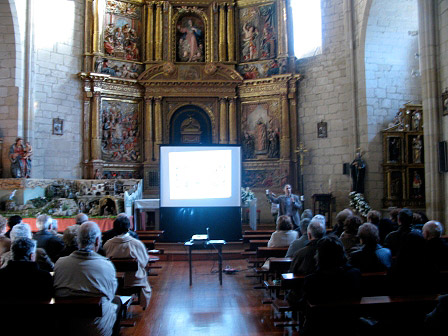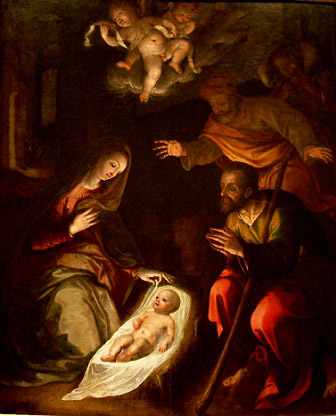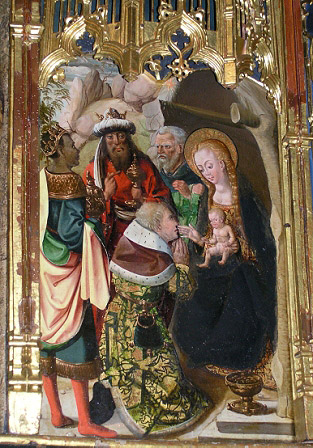December 21, 2014
Lectures
CHRISTMAS CYCLE
Christmas prints in Navarrese art
Mr. José Javier Azanza López
Chair of Navarrese Heritage and Art
Before a crowded audience that gathered in the parish of Our Lady of the Assumption of Villatuerta, Javier Azanza made a religious and artistic journey through the so-called "Christmas Triptych", which includes the episodes of the advertisement and Adoration of the Shepherds, the Slaughter of the Innocents and the Flight into Egypt, and finally the cycle of the Magi.

The lecture took place in the parish of Villatuerta.
One of the great themes of Christmas iconography is that of the advertisement and Adoration of the Shepherds, in which St. Luke clearly separates two consecutive moments: the advertisement of the angel to the shepherds, and their arrival at portal in Bethlehem, where they found the Child reclining in a manger. During most of the Age average the attention of artists is focused only on the first part of the episode, that is, on the advertisement with the appearance of the angel, conceived either as an independent scene or as a background to the Nativity. It was not until the 15th century that the representation of the adoration of the shepherds in the portal of Bethlehem became generalized, displacing the topic of advertisement in the following centuries. The text of the evangelist leaves the door open to multiple interpretations and possible variants of representation of the scene, from the reverent and silent, to the joyful and boisterous with songs and humble gifts to the newborn.

Fitero. Parish Church of Santa María. Main altarpiece
Adoration of the shepherds, 1590. Rolán Mois
The order decreed by Herod to kill the innocents, one of the most dramatic themes in the history of sacred art, and the flight to Egypt of Mary and Joseph with the Child, open the last period of Christ's childhood. Although the Gospels of St. Matthew and St. Luke contain hardly any references to these years, apocryphal texts and devotional literature come to their aid. In the Age average, the representations of the slaughter follow an almost unique model : Herod, seated on the throne, gives the order and before his eyes the soldiers kill the children, which sometimes the mothers try to protect. On the contrary, in the Modern Age Herod gradually loses prominence until he finally disappears from the scene, which is centered on the slaughter itself. The flight of the Holy Family to Egypt is based on some essential elements: Mary, with the Child in her arms, rides on a donkey led by Joseph, in his role of protector of the Holy Family; sometimes an angel accompanies them to guide and sample the way. Less frequent is the presence of a woman that according to the Apocryphal Gospels we must identify with Salome, the unbelieving midwife. Mary's fatigue from the journey forces her to rest, which provides a new scene with numerous representations in the history of art. There is also no lack of miraculous events that occurred during the journey, some of which reached a certain iconographic diffusion, as in the case of the miracle of the palm tree and the miracle of the wheat. In the return of the Holy Family, the Child walks hand in hand with his parents, and does not travel in the arms of the Virgin.
One of the most successful episodes in the history of art has been that of the Adoration of the Magi, a paradoxical circumstance a priori if we consider the scarce data provided by the account of St. Matthew, the only one of the four evangelists who collects the extraordinary event. To establish an iconography of the Magi we must delve into their theological, historical and legendary reality to determine their origin, issue, name, appearance and offerings, to which authors and texts such as Tertullian, Origen, Pope Leo I, the Armenian Gospel of the Infancy (4th century) and the Liber Pontificalis of Ravenna (9th century) contribute.
Having clarified these aspects, organizing a narrative cycle is relatively simple, since the Gospel story points out each of the episodes: the appearance to the Magi of the miraculous star announcing the birth of the Messiah; the journey or cavalcade of the Magi, guided by the star and on camelback or horseback, from agreement with the more or less pronounced taste for oriental exoticism; the visit of the Magi to King Herod, which is not lacking in medieval art, with Herod characterized as a sovereign of the time with his attributes of power, seated on his throne, with crown and scepter or sword; the Adoration of the Child, central scene of the cycle whose abundance and representations allow us to establish a series of formulas used in the different periods of the history of art with variations in the composition, characters and attitudes; the Magi warned in dreams by an angel; and, finally, the return to Tarsus by boat, according to Santiago de la Vorágine in the Golden Legend.
The above episodes find their expression in Navarrese art of the average and Modern Ages, in a group of sculptural and pictorial works in different media that make up an attractive Christmas tour, for which Javier Azanza selected examples from the cathedrals of Pamplona and Tudela, the Museum of Navarre, the sanctuary of the Yugo de Arguedas and the Shrine of Our Lady of Fair Love de la Esperanza de Valtierra, and the parishes of Los Arcos, Huarte, Artajona, Fitero, Ororbia, Villatuerta, Valtierra, Desojo, Ilundáin (Valle de Aranguren), Eguiarte, Ujué, San Saturnino de Pamplona, San Miguel and San Pedro de la Rúa de Estella, Santa María de Viana, Santa María de Tafalla, la Magdalena de Tudela, Santa María de Olite, Santa María de Sangüesa and Santiago de Puente la Reina.

Los Arcos. Parish of Santa María
Altarpiece of the Visitation. First third of the XVI century
Adoration of the Magi, attributed to Pedro Díaz de Oviedo.
